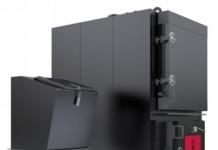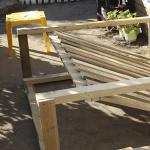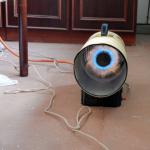Decided to assemble a homemade heater for your home or garage, but don't know how? I bring to your attention 4 simple ideas for making an electric fireplace, a heat gun, a candle stove and an infrared burner. I will tell you how to assemble such a heater in 1 hour.
What can be made from improvised materials

Everyone can make an electric heater with their own hands, even without being a professional electrician. Consider two step-by-step instructions for assembling a heat gun and a spiral fireplace.
Idea one - assembling an electric spiral fireplace
Such a fireplace will be a good solution for heating rooms with a small area. For example, having made an electric heater with your own hands, it will be possible to heat a home workshop or office.
| Illustration | Materials and tools, and their description |
 |
Brick solid kiln. One ceramic brick will be used as a dielectric body for winding the helix. Two bricks will be used as heat dissipators. |
 |
Tungsten or nichrome wire. A wire made of refractory alloys is needed for winding a spiral. For normal heating, we use a wire with a diameter of at least 0.5 mm.
|
 |
metal strip. A strip of steel 20-30 mm wide and 3 mm thick is needed in order to make a reinforcing frame of the structure. |
 |
Grinder with a cutting disc for concrete. We will use the grinder for cutting bricks, and therefore a regular metal disc will not work. |
 |
Welding machine. During installation, you will have to cook a metal strip. If there is no experience with welding, you can use a bolted connection. |
| Illustrations | Description of actions |
 |
We make notches.
|
 |
Heating element manufacturing. Previously prepared nichrome or tungsten wire is wound over the brick, holding in the notches. |
 |
Production of heat-accumulating surfaces.
|
 |
Installing the legs.
|
 |
Manufacturing of a protective case. The heater is almost ready, but in order to be safe to use, we assemble a pipe with a rectangular cross section from tin. The assembled pipe should be 2-3 cm wider than the brick structure.
|
 |
Protective housing installation. We install the protective casing over the bricks, so that the same gap is maintained between them and the tin on all sides. Perhaps for this you will have to weld additional spacers from a metal strip. |
 |
Wiring and trial run. A wire with a plug is connected to the two ends of the spiral, through the connecting terminals or by twisting. Before a test run, inspect the entire structure and make sure that the turns of the homemade spiral do not touch. After that, the design can be connected to the network and tested in operation. |
Idea two - assembling a heat gun from a bucket and a twisted spiral

To make such a heater, you will need a metal bucket, a large built-in fan and a spiral from an old electric stove. For assembly, ordinary tools will suffice, which are likely to be found in any home workshop.
The table offers simple installation instructions.
| Illustration | Description of actions |
 |
Separate the bottom. We separate the bottom from the prepared bucket so that we get a cylinder without a bottom and without a top. |
 |
Preparing the spiral. We cut a square metal grate to the size of the bucket. We lay the spiral along the grate so that the diameter of its layout is somewhat smaller than the inner diameter of the bucket. |
 |
Spiral installation. In the prepared bucket, we make slots into which we insert the corners of the lattice. As a result, the grate with a spiral should be indented 30 mm from the edge of the bucket. |
 |
Wiring and switch installation. We bring out the wires from the spiral. For safety, we output the wiring through insulators. Immediately, on the sidewall of the bucket, we install an isolated block of automatic machines. |
 |
Fan installation. On the opposite side of the grate with a spiral, install a fan. We attach the fan to the walls of the bucket with self-tapping screws and connect it to the machines. |
 |
Installation of supports. As shown in the photo, we drill through holes along the edges of the bucket. Through the holes we pass the studs, which we fix with nuts. As a result, the structure should not sway and should be stable. |
 |
Trial run. We turn on the gun in the network and first start the fan. After we turn on the power to the spiral. |
The third idea is to make a micro-oven on a spirit lamp or a candle

Yes, this is not a typo - such a stove takes up little space, and an ordinary candle or spirit lamp is used as fuel for intensive heating!

To make a heater, you will need two clay pots of different sizes and a spirit lamp. Of the tools you will need a drill with a drill bit, a pencil and a ruler. So, let's get to work.
| Illustration | Description of actions |
 |
Making markings on a small pot. From the center of the bottom of the pot, mark a line that will divide the bottom in half. Now, relative to the line that has already been drawn, we draw a transverse line to make a cross. From these lines we pass to the walls and, as shown in the photo, mark a point on each side. Each of the points should recede from the bottom by 20 mm. |
 |
Drilling holes. According to the markings made, one hole must be drilled on each side of the pot. That is, there should be four holes.
|
 |
Preparing a large pot. Similarly, we drill two holes in a large pot. But the holes in a large pot should not be located near the bottom, but along the edge. |
 |
We light the fuel. We fill the spirit lamp with alcohol or similar liquid fuel. We put the spirit lamp on the stand and light it.
|
 |
Installing the first pot. After the spirit lamp flares up, we place a large pot on top of it. We do this so that the flame from the spirit lamp knocks out of the hole for the water drain. We wait 5 minutes until the moisture collected by the ceramics during drilling is completely evaporated. |
 |
Installing the second pot. We put a small pot on an already dried out large pot. The location of the holes relative to each other is not important, since they are needed for traction and provide it, even if they do not match. |
Answers to questions on the use of the heater

How hot and for how long? If the stove is assembled correctly, the heat obtained from a spirit lamp or from a candle is enough to heat a small room for half an hour. The fuel in the spirit stove burns out within 15-20 minutes, heating the ceramic pots and the air underneath them to a high temperature.
After that, within 10-15 minutes, ceramics will slowly release heat into the environment, that is, into the room.

How dangerous is the oven? As you can see, in the photo, the air heating temperature at the outlet of the pot, at the highest point, is very high. But in the lower part of the pot, this temperature does not rise above +30 ° C.
That is, cotton swabs or other flammable objects may lie close to them, and nothing will happen to them. But it is not recommended to touch the top of the stove during operation.
Can the stove be painted? Although the ceramic itself looks good, the pots can be coated with special heat-resistant oven paints and varnishes.
Can epoxy be used to glue pots together? No, epoxy and similar two-part formulations are not heat resistant. For example, epoxy adhesive begins to break down already at a temperature of +60 °C.
Idea four - making an infrared heater in 5 minutes

Heaters operating on the principle of infrared radiation are most often electric. I will show you how to make an infrared gas heater. The device is very simple and for its assembly you need: a camping gas burner, a piece of metal mesh for sifting sand and a plumbing clamp.
| Illustration | Description of actions |
 |
Diffuser manufacturing. We turn a piece of mesh 20 × 30 cm into a tube 20 cm long. That is, the tube should be wound in 3 layers. |
 |
Installing the diffuser on the burner. We put a mesh tube on the burner nozzle. We put a plumbing clamp over the tube and tighten it with maximum effort. |
 |
We continue to talk about homemade electrical appliances and our new master classes touched on electric heaters. In fact, assembling a simple heating element at home is not difficult even for an inexperienced electrician. You just need to have available improvised tools and a scheme according to which the assembly should be carried out. Next, we will bring to your attention some interesting ideas with photo and video examples that will show you how to make a do-it-yourself heater for your home, garage and even a car!
Idea No. 1 - Compact model for local heating
The easiest way to make an electric heater is this one. To get started, prepare the following materials:
- 2 identical rectangular glasses, each with an area of \u200b\u200babout 25 cm2 (for example, 4 * 6 cm in size);
- a piece of aluminum foil, the width of which is not greater than the width of the glasses;
- cable for connecting an electric heater (copper, two-wire, with a plug);
- paraffin candle;
- epoxy adhesive;
- sharp scissors;
- pliers;
- wooden block;
- sealant;
- several ear sticks;
- clean rag.
As you can see, the materials for assembling a homemade electric heater are not at all scarce, and most importantly, everything can be at hand. So, you can make a small electric heater with your own hands according to the following step-by-step instructions:

Using this technology, you can make an electric mini heater with your own hands. The maximum heating temperature will be about 40o, which will be quite enough for local heating. However, for heating a room, such homemade products will, of course, be small, so below we will provide more efficient options for homemade electric heaters.
Idea number 2 - Mini-heater from a can
Another original model of a homemade electric heater, which is suitable for local heating in a garage or room. All you need to build is:
- coffee can;
- transformer 220/12 Volt;
- diode bridge;
- cooler;
- nichrome wire;
- textolite, with an area approximately the same as the diameter of the can;
- drill with a thin drill;
- soldering iron;
- cord for connecting to the network;
- push button switch.
This instruction is even simpler and you can make an electric heater from a jar with your own hands in 1-2 hours. To begin with, you need to remove the foil from the textolite and cut out the middle in it, as shown in the photo below:

After that, using a drill, you need to make holes diagonally. By the way, for this you can make a homemade mini drill according to our instructions. We fix the nichrome wire into the holes, after which we solder the wires.


We connect a transformer, a diode bridge, a cooler, a nichrome wire and a switch into one circuit.

We mount the fan in a jar using glue, after which we fasten the textolite as shown in the photo:


We put all the elements of a home-made electric heater in the jar, drill holes in the lid and check the operation of the device! 
Idea No. 3 - Economical infrared device
So we are moving on to more powerful electric heaters that you can easily make yourself at home. To make an infrared heater, we need the following materials:
- 2 sheets of plastic, the area of each is 1 m2;
- graphite powder, crushed to flour fraction;
- epoxy adhesive;
- two copper terminals;
- cord with a plug for connection to a network of 220 Volts.
So, you can make a room infrared heater with your own hands according to the following instructions:

By the way, in order to make the structure more durable, it is recommended to place the infrared heater in a wooden frame, which can also be made by hand. Do not forget to check the resistance of the device before connecting and calculate the power!
Idea #4 - Oil Appliance
Another model of the device, which is recommended to be assembled for heating a garage or other outbuildings in the country. All you need is an old battery, tubular heater, oil and cork. You will also need a welding machine, welding skills and some free time. The photo below shows one of the options for a homemade oil heater.

A tubular heater is installed at the bottom left, at the top there is a plug for draining / filling oil. A simple design of an electric heater, which will be enough to heat a small room.
Idea number 5 - Car electric oven
Well, the last version of a homemade heater is a device that runs on 12 volts, which can be used to heat the interior of your own car. For assembly you will need the following materials:
- old computer power supply;
- nichrome wire;
- remnants of floor tiles;
- fasteners: bolts, angles, plates.
It is not so difficult to make an electric heater for the car yourself. It is recommended to view the assembly process at the master class in photo examples.
The main thing is safety.
When is a homemade heater needed for a home, cottage or garage? To make heaters with their own hands, ordinary people are pushed by the lack of central heating (in the case of a garage or a country house). For the home, home-made heating equipment will be needed during construction work or in the autumn-spring period, when the centralized heat supply is either not yet turned on or has already been stopped. By the way, this is the best time to do it.
People make a do-it-yourself heater for the home in order to save on the purchase of factory-made equipment, the price of which can be very high. However, regardless of the reasons why homemade heating devices are made, all work must be carried out professionally and in strict accordance with state standards for the safe operation of such equipment.
The right homemade heater for the home
Regardless of the type of heating equipment being manufactured and the type of energy carrier used, the equipment must meet the following requirements:
- be easy to manufacture;
- have a low cost of structural materials and elements;
- have high performance;
- sufficient power;
- be safe to use;
- be cost-effective in terms of production and consumption of energy;
- as compact as possible;
- simple and convenient to use.
Any factory-made heater can boast of safety, economy and efficiency. Homemade technology is characterized by increased power, performance, ease of use, but safety is a controversial issue. That is why any homemade heater for the home needs to be checked before mass use.
Efficient infrared emitter
Any infrared emitter that is used to heat a room is characterized by efficiency and high efficiency. All this is achieved thanks to the unique principle of operation. Waves in the infrared spectrum do not interact with the air, but increase the surface temperature of objects in the room.
Those subsequently transfer heat energy to the air. Thus, the maximum of radiant energy transforms into thermal energy. It is precisely because of the high efficiency and efficiency, and also because of the low cost of structural elements, that infrared heaters are increasingly being made independently by ordinary people.
IR emitter based on graphite dust.

Epoxy adhesive.
operating in the infrared spectrum, can be made from the following elements:
- powdered graphite;
- epoxy adhesive;
- two pieces of transparent plastic or glass of the same size;
- wire with a plug;
- copper terminals;
- thermostat (optional)
- wooden frame, commensurate with pieces of plastic;
- tassel.

crushed graphite.
First, prepare the work surface. For this, two pieces of glass of the same size are taken, for example, 1 m by 1 m. The material is cleaned of contaminants: paint residue, greasy hand marks. This is where alcohol comes in handy. After drying, the surfaces proceed to the preparation of the heating element.
The heating element here is graphite dust. It is a conductor of electric current with high resistance. When connected to the mains, graphite dust will begin to heat up. Having gained a sufficient temperature, it will begin to emit infrared waves and we get a do-it-yourself IR heater for the house. But first, our conductor needs to be fixed on the work surface. To do this, you need to mix the carbon powder with the adhesive until a homogeneous mass is formed.

Homemade room heater.
Using a brush, we make paths from a mixture of graphite and epoxy onto the surface of previously cleaned glasses. This is done in a zigzag pattern. The loops of each zigzag should not reach the edge of the glass by 5 cm, while the graphite strip should end and begin on one side. In this case, it is not necessary to make indents from the edge of the glass. Terminals for connecting electricity will be attached to these places.
We put the glasses on top of each other with those sides on which graphite is applied, and fasten them with glue. For greater reliability, the resulting workpiece is placed in a wooden frame. Copper terminals and a wire are attached to the exit points of the graphite conductor on different sides of the glass to connect the device to the mains. Next, home-made heaters for the room must be dried for 1 day. You can connect a thermostat in a chain. This will simplify the operation of the equipment.
What are the advantages of the resulting device? It is made from improvised means, and therefore, it has a low cost. It heats up no higher than 60 ° C, and therefore it is impossible to burn yourself on its surface. The glass surface can be decorated at your discretion with a film with a variety of patterns, which will not violate the integrity of the interior composition. Do you want to make homemade gas heaters for your home? The video will help solve this problem.
Film IR heater. For full heating of a medium-sized room, it is recommended to use ready-made film materials capable of emitting IR waves. They are present in abundance in today's market.
When buying a film material, you need to pay attention to the composition of its heating element. The latter should not contain lead. It is hazardous to health. A quality product must be accompanied by a quality certificate.
Required structural elements:

Preparing the wall surface for a home-made heater for an apartment begins with fixing the thermal insulation. Its thickness should be equal to at least 5 cm. To do this, the protective film is removed from the self-adhesive layer and the polystyrene is attached to the surface with the foil up. In this case, the material must be pressed tightly against the wall. An hour after the end of work, you can proceed to the next step.
Sheets of IR film are interconnected in series. Glue is applied to the back of the material with a spatula. All this is attached to the previously mounted polystyrene. It will take 2 hours to securely fix the heater. Next, a cord with a plug and a thermostat are attached to the film. The final step is decoration. To do this, the prepared fabric is attached over the film using decorative corners.
We make an oil heater with our own hands

Homemade register with heating element and air vent.
Firstly, the container for the future radiator must be absolutely sealed. Otherwise, the coolant will flow out, which will lead to overheating of the heating element (heater). Therefore, you need to master some techniques for proper metal welding. We talked about them in an article about.
Secondly, mineral oil should act as a coolant here, if possible, transformer oil. It should fill the tank of the heater by 85%. The rest of the space is left under the air. It is necessary to prevent water hammer. Thirdly, in the case of using a cast-iron tank for a heater, a steel heating element is used. For a stainless steel tank, a copper heating element is suitable. Magnesium anodes cannot be used in this system.

Use a sketch.
Source materials:
- old, cast-iron radiator or steel pipes with a diameter of 15 cm, pipes with a diameter of 7 cm;
- transformer oil;
- thermostat;
- two-core cord with a plug at the end;
- pump up to 2.5 kW.
You will have to work with a welding machine, a drill, a set of drills and electrodes. Pliers will come in handy. Making an oil heater

Ten is inserted into the lower end.
do-it-yourself apartments begin with the preparation of the tank. If an old, cast-iron battery was taken, it must be disassembled into sections and thoroughly cleaned from dirt and rust, be sure to degrease the inner surface. If you need a heater with increased power, then a welded structure is prepared from prepared pipes, where pipes of larger diameter are located horizontally.
Pipes of smaller diameter are jumpers between the main ones. The coolant will circulate through them. It must be remembered that in the lower pipe it is necessary to set aside a hole for mounting the heating element. If there are several heating elements, they are located on opposite sides of the tank and should not touch. Leave a hole for the pump. The heating element is securely fixed with bolts. A hole for it can be made with a grinder or autogenous.
If a do-it-yourself heater for a room turns out to be voluminous and natural circulation of the coolant in it is impossible, they resort to using a pump. It is located at the bottom of the equipment. The pump must not come into contact with the heating element.
After the installation of structural elements, the equipment is checked for tightness. If the result is satisfactory, then the coolant is poured. The drain hole is securely sealed with a stopper. The equipment is connected to the mains in parallel. The scheme is supplemented with a bimetallic thermostat from an ordinary iron. Before the first start-up, the installation is grounded. Homemade oil heaters for the home: the video will explain in detail about their device and installation rules:
Advantages of homemade heaters
Do-it-yourself heater for summer cottages and home-made heating appliances for the home have one indisputable advantage over factory counterparts. The first are made from improvised means, and therefore their cost is low. On the other hand, home-made equipment must be made in strict accordance with the rules for the safe operation of electrical and gas appliances. Today, you can make your own IR heaters, which are considered the most efficient and inexpensive. If you need a device of increased power, then you can make an oil cooler at home. There are schemes for the manufacture of home convectors, portable stoves for tents.
A simple homemade panel heater: assembly diagram, manufacturing photo.
With the onset of cold weather residential heating becomes relevant, and many are wondering how to additionally heat a living room, workroom, cottage or garage using a heater. In this article we will look at how to make a simple, cheap and at the same time safe electric heater.
The cross section and length of the wire must be selected based on the required heater power, you can use the provided table.
If you need a heater with a power of 500 W, then you will need a nichrome wire with a cross section of 0.4 mm and a length of 9.7 meters.
To calculate the length of the wire, you can use the table.
More materials needed:
- Epoxy adhesive.
- Bolts, washers, nuts - 2 pcs.
- Wire and plug.
Electric circuit of a homemade heater.
Let's start making a heater.
Each sheet of fiberglass must be cleaned on one side with a grinder, this will be the inside of the heater.
We take one sheet of fiberglass, we will lay nichrome wire on it. Depending on the size of the sheet, it is necessary to calculate the number of turns of wire, while taking into account the indent from all edges of the sheet of 20 - 30 mm. The optimal distance between the turns is 10 - 15 mm.
For example: if we have a length of a fiberglass sheet a little over a meter, then for laying 24 meters of wire, it will take about 24 turns to make.
For convenience, before laying the wire, it is advisable to draw a frame for the turns on the sheet.
Now you need to lay the wire in turns along the frame, you can fix the turns with paper strips and Monolith glue.
At the exit point of the wire, you need to drill two holes in the fiberglass to make terminals and connect the cord to the plug.
We check the integrity of the circuit with the device.
Now you need to glue the second sheet of fiberglass to the first one using epoxy glue. Epoxy glue is applied along the edges of the sheet and between the turns of the wire.
We glue the sheets together so that the sheets stick together evenly, they must be laid on a flat surface, pressed on top with a sheet of chipboard or plywood and pressed down with a load. After a day, the sheets will firmly stick together, and the heater will be ready.
A homemade heater can be hung on the wall, and it will not take up space in the room.
The heater itself is safe, since the heating element is hidden in fiberglass, and this is an insulating material, but you still need to follow safety measures and not leave the heater unattended.
Today, unlike the times of the Soviet period, you can buy any heater. These may be expensive models with many additional features. And you can buy models simpler and cheaper. Have you ever wondered how to make a heater with your own hands? Firstly, it is interesting, and secondly, it saves you a lot of money, because you don’t have to buy components to assemble a heating device, because you probably have them in stock.
Requirements for a homemade heater
But, how to make a home-made heater, so as not to buy expensive components of the device, and also not to turn the assembly process into a complex hard-to-solve problem. To begin with, the future heater must simply meet the minimum requirements that are needed for its productive operation.
- Operational safety.
- Tangible result from the operation of the heater.
- Not high power consumption (otherwise, what's the use of such a device).
- Small dimensions (thermal home station, agree that no one needs it).
Consider the simplest technology on the basis of which you can assemble your own heater, this is the principle of the thermal film.
Such a device simply cannot work in vain, but the power it consumes will also be small, and, therefore, such a heater will also consume energy economically. By this principle, you can make a homemade infrared heater.
The elements that are required to assemble the device do not have to be bought in radio products or specialized stores. You will probably find most of the components at home. So, you will need the following materials:
- Glass. Two identical blanks of rectangular size. The area is about 25 sq. cm.
- Aluminium foil.
- Soldering iron.
- Glue (preferably epoxy).
- Scissors capable of cutting foil evenly.
- Paraffin candle.
- Sealant.
- Two-core cable with plug.
Step by step assembly
Light a candle and begin to slowly ensure that the surface becomes covered with a layer of soot. You only need to do this on one side. Do the same with the second glass blank.
Next, step back from each edge of the glass about 50 mm (half a centimeter) and remove the soot with a cotton swab. Cut out strips from the foil, the size of which corresponds to the size of the created conductive surface (black square). The foil plays the role of electrodes. On the surface of the glass, on the side where the soot is located, apply glue. Attach a piece of foil to the glue, but so that part of it extends beyond the glass.
Now the homemade product must be tested, measure the current power. To do this, use the formula: P = I2R, where
P - current power
I - current strength in amperes
R - resistance in ohms
If the received power falls within the permissible limits, which are indicated in the specialized literature, then the device can be connected to the network. If not, then it is better to try to collect it again. At the same time, keep in mind that the resistance directly depends on the layer of soot on the glass. That is, the larger the soot layer, the lower the resistance and the more the glass will heat up.
According to this scheme, even a schoolboy can make a homemade heater for 12 volts. But still, for the final stage, it is better to provide such a device with special devices for control.
The above assembly diagram is good when there is electricity nearby. But after all, there are often situations when you need to heat a small space without having any electricity. How to get out of this situation?

If the need forces you to be in places where there is no electricity, then for sure you have the most ordinary gas burner with a small cylinder. It is designed to heat containers that simply need to be installed above the flame. But if it is slightly improved, then you can get a very functional home-made heater for a winter tent.
For such a device, a mesh heat dissipator is initially installed on the burner. To save money, you can also make it yourself from a regular household sieve. Fasteners for fixing to the burner can be cut out of galvanized steel, according to the diameter of the sieve, by adding four small squares, which will act as fasteners.
Once you attach the sieve to the cylinder adapter, the resulting thermal effect will be greater, but still not enough to feel comfortable. Therefore, the design will have to be further improved.
To do this, you need a metal mesh. From it cut the workpiece according to the diameter of the sieve, the height of the workpiece is twice the height of the sieve. Another fastener needs to be cut out of the galvanized sheet, in which it is desirable to make small holes along the edges, along the entire diameter. This will improve traction.
Such a home-made nozzle can be put on with an adapter on a collet cylinder and on a gas one - the effect is approximately the same. But believe me, it will exceed all your expectations. It is quite possible to make a gas heater with infrared radiation without large financial costs. And the effect is simply breathtaking.
Everyone knows that in severe frosts the basement also requires additional heating, since frozen potatoes are not only not tasty, but they will not be stored for a long time after they have frozen.
For such a device, the following materials will be required: special sheet plastic (laminated paper plastic sheets), powdered graphite, wire with a plug, epoxy glue.

Assembly is carried out in several stages.
- First you need to mix the epoxy and powder very carefully. Thus, you get a high-resistance adhesive. The more graphite powder there is, the more the device will heat up.
- The resulting graphite adhesive is applied to the rough surface of the plastic sheet. Next, the plastic is connected. In order to securely fix the sheets, it is better to put together a wooden frame.
- Attach copper terminals on two opposite sides of the structure.
- Now the future heater needs to be dried very carefully. The fact is that even a small amount of moisture can lead to breakage the first time you turn on the device.
- The last step is to check the power of the device. If it corresponds to the norm, then the heater can be connected to the network.
Now the device can be used. This version of the heater can be hung on the wall, put on the floor (however, this option is unlikely to be appropriate for the basement).
In a similar way, you can make a homemade heater for a car.
In addition to such simple methods, there are more complex options for assembling homemade heaters. Some use special circuits in devices, transistors and resistors.
In any case, all homemade heaters have one thing in common. First, all materials that are used in the device must be in good condition. For example, if you decide to use a wire with a plug from an old iron, then first make sure that it is not damaged anywhere and that it can be safely connected to the heater.
Be sure to measure the resistance of the device and calculate the power. These conditions must be met, because it primarily concerns the safe use of the device. It is necessary that when you turn it on, you are calm that the heater is working properly and any damage due to incorrect power or inappropriate resistance is simply excluded.
Do not forget to carefully insulate all conductive elements, contacts for additional built-in devices. Check wires. Only in this case you will be calm for the operation of your device. And he, in turn, will work flawlessly, and heat the room.



















